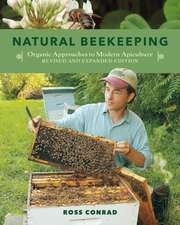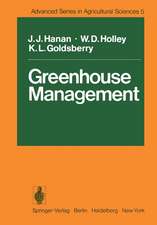The Western European Loess Belt: Agrarian History, 5300 BC - AD 1000
Autor Corrie C. Bakelsen Limba Engleză Paperback – 11 sep 2014
Subjects covered are crops, crop cultivation, livestock and livestock handling, the farm and its yard, and the farm in connection with other farms. Crop plants and animals are described, together with their origin. New tools such as the plough, wheen, wagon and scythe are introduced. Groundplans of farm buildings, the history of the outhouse and the presence or absence of hamlets are presented as well, and the impact of farming on the landscape is not forgotten.
The loess belt was not an island and the world beyond its boundaries was important for new ideas, new materials and new people.
Summarising six millennia of agriculture, the thinking in terms of the Western European loess belt as one agricultural-cultural unit seems justified.
| Toate formatele și edițiile | Preț | Express |
|---|---|---|
| Paperback (1) | 890.68 lei 6-8 săpt. | |
| SPRINGER NETHERLANDS – 11 sep 2014 | 890.68 lei 6-8 săpt. | |
| Hardback (1) | 896.84 lei 6-8 săpt. | |
| SPRINGER NETHERLANDS – 10 aug 2009 | 896.84 lei 6-8 săpt. |
Preț: 890.68 lei
Preț vechi: 1086.20 lei
-18% Nou
Puncte Express: 1336
Preț estimativ în valută:
170.45€ • 176.94$ • 142.13£
170.45€ • 176.94$ • 142.13£
Carte tipărită la comandă
Livrare economică 22 martie-05 aprilie
Preluare comenzi: 021 569.72.76
Specificații
ISBN-13: 9789400791367
ISBN-10: 9400791364
Pagini: 308
Ilustrații: VIII, 295 p.
Dimensiuni: 155 x 235 x 16 mm
Greutate: 0.44 kg
Ediția:2009
Editura: SPRINGER NETHERLANDS
Colecția Springer
Locul publicării:Dordrecht, Netherlands
ISBN-10: 9400791364
Pagini: 308
Ilustrații: VIII, 295 p.
Dimensiuni: 155 x 235 x 16 mm
Greutate: 0.44 kg
Ediția:2009
Editura: SPRINGER NETHERLANDS
Colecția Springer
Locul publicării:Dordrecht, Netherlands
Public țintă
ResearchCuprins
The Loess-Covered Region West of the River Rhine, 5300 BC–AD 1000.- Sources.- The Beginning: 5300 BC–4900 BC.- Heirs to the First Farmers: 4900 BC–4300 BC.- Innovation and Expansion: 4300 BC–2650 BC.- The First Millennia of Agricultural Landscape.- Towards a More Complex Society: 2650 BC–50 BC.- of the Roman Empire: 50 BC–AD 407.- The Early Middle Ages: AD 407–AD 1000.- The Birth of the Cultural Landscape.- Summing Up Six Millennia of Agriculture.
Textul de pe ultima copertă
This book deals with the early history of agriculture in a defined part of Western Europe: the loess belt west of the river Rhine. It is a well-illustrated book that integrates existing and new information, starting with the first farmers and ending when food production was no longer the chief source of livelihood for the entire population. The loess belt was chosen because it is a region with only one type of soil and climate as these are all-important factors where farming is concerned.
Subjects covered are crops, crop cultivation, livestock and livestock handling, the farm and its yard, and the farm in connection with other farms. Crop plants and animals are described, together with their origin. New tools such as the plough, wheen, wagon and scythe are introduced. Groundplans of farm buildings, the history of the outhouse and the presence or absence of hamlets are presented as well, and the impact of farming on the landscape is not forgotten.
The loess belt was not an island and the world beyond its boundaries was important for new ideas, new materials and new people.
Summarising six millennia of agriculture, the thinking in terms of the Western European loess belt as one agricultural-cultural unit seems justified.
Audience:
This book will be of interest to researchers in archaeology, history and agriculture, and to landscape engineers.
Subjects covered are crops, crop cultivation, livestock and livestock handling, the farm and its yard, and the farm in connection with other farms. Crop plants and animals are described, together with their origin. New tools such as the plough, wheen, wagon and scythe are introduced. Groundplans of farm buildings, the history of the outhouse and the presence or absence of hamlets are presented as well, and the impact of farming on the landscape is not forgotten.
The loess belt was not an island and the world beyond its boundaries was important for new ideas, new materials and new people.
Summarising six millennia of agriculture, the thinking in terms of the Western European loess belt as one agricultural-cultural unit seems justified.
Audience:
This book will be of interest to researchers in archaeology, history and agriculture, and to landscape engineers.
Caracteristici
The only book sofar that covers such a long period Integration of information only available in specialized journals and reports mainly written in German and French, and to a limited extent in English and Dutch, combined with new material Offering information on the entire range of crops, livestock, tools, farm-buildings, presence or absence of hamlets and the impact on the environment







